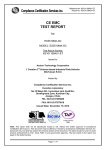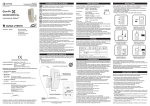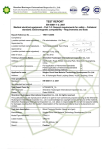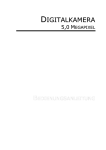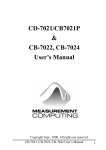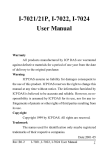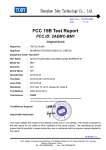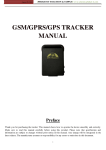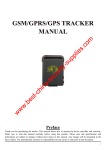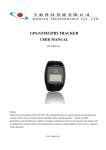Download Photos of Test Setup
Transcript
Report No.: SH08040007E01 TABLE OF CONTENTS 1. TEST CERTIFICATION...........................................................................................................4 2. GENERAL INFORMATION ....................................................................................................5 2.1 EUT Description .........................................................................................................................5 2.2 Test Standards and Results ........................................................................................................7 2.3 Test Equipments Used ................................................................................................................8 2.4 Facilities and Accreditations......................................................................................................9 2.4.1 Facilities ....................................................................................................................................9 2.4.2 Test Environment Conditions....................................................................................................9 2.4.3 Measurement Uncertainty .........................................................................................................9 3. EMISSION TESTS...................................................................................................................10 3.1 EUT Setup and Operating Conditions....................................................................................10 3.2 Radiated Disturbance...............................................................................................................11 3.2.1 Limits of Radiated Disturbance ..............................................................................................11 3.2.2 Test Procedure.........................................................................................................................11 3.2.3 Test Setup ................................................................................................................................11 3.2.4 Test Result...............................................................................................................................12 4. IMMUNITY TESTS .................................................................................................................14 4.1 EUT Operation and Performance Criteria ............................................................................14 4.1.1 EUT Setup and Operating Conditions.....................................................................................14 4.1.2 Performance Criteria ...............................................................................................................14 4.2 Electrostatic Discharge Immunity...........................................................................................16 4.2.1 Test Specification ....................................................................................................................16 4.2.2 Test Procedure.........................................................................................................................16 4.2.3 Test Setup ................................................................................................................................17 4.2.4 Test Result...............................................................................................................................17 4.3 Radiated Radio Frequency Electromagnetic Field Immunity..............................................18 4.3.1 Test Specification ....................................................................................................................18 4.3.2 Test Procedure.........................................................................................................................18 4.3.3 Test Setup ................................................................................................................................18 4.3.4 Test Result...............................................................................................................................19 Page 2 of 25 Report No.: SH08040007E01 PHOTOS OF THE EUT .....................................................................................................................20 PHOTOS OF TEST SETUP...............................................................................................................24 Page 3 of 25 Report No.: SH08040007E01 2. GENERAL INFORMATION 2.1 EUT Description EUT Type..............................: Model Name .........................: Serial No...............................: Hardware Version .................: Software Version ..................: Modulation Type...................: Accessory Equipment 1……: GSM/GPRS 850/900/1800/1900 Module SIM340 (n.a., marked #1 by test site) V7.03 TTPCom 10.0 GMSK Evaluation Band Model Name: (n.a.) Trade Name: (n.a.) Manufacturer: (supplied by applicant) Serial No.: (n.a., marked #1 by test site) Accessory Equipment 2.…...: AC Adapter Model Name: DSA-0131F-06EU12 Brand Name: DEEVAN Serial No.: (n.a. marked #1 by test site) Rated Input: 100-240V, 0.3A,50/60Hz Rated Output: 6V, 2A Manufacturer: DEEVAN ELECTRONICS(JIAXING) CO,.LTD Wire Length: 183cm Test Sample Sketch...............: The EUT (Module) is positioned on the Evaluation Board (Ancillary Equipments 1) which is powered by AC Adapter (Ancillary Equipments 2). The EUT (Module) can not work without the Evaluation Board together with the AC Adapter. (see the figure below) EUT AC Adapter Evaluation Board PC During the tests, a special program, supplied by applicant, installed in a Personal Computer (PC) is employed to control the Test Sample to work appropriately through their serial ports. Page 5 of 25 Report No.: SH08040007E01 Note 1: The EUT is a GSM/GPRS Module which supports GSM 850MHz, 900MHz, 1800MHz, 1900MHz bands, and GSM 900MHz and DCS 1800MHz bands are tested in this report. Note 2: During the tests in this report, a Personal Computer is employed to control the EUT to work appropriately through their serial port. Note 3: The test results in this report are ONLY for the configuration of “EUT (Module) + Ancillary Equipments 1 + Ancillary Equipments 2” as listed above. The EUT (Module) is considered a component which will be installed into final equipment; the final equipment must be re-confirmed that it still meets EMC directives. Note 4: Please refer to 0 for the photographs of the EUT. For a more detailed description, please refer to Specification or User’s Manual supplied by the applicant and/or manufacturer. Page 6 of 25 Report No.: SH08040007E01 2.2 Test Standards and Results The objective of the report is to perform testing according to following standards for CE marking: No. 1 2 Identity Document Title ETSI EN 301 489-7 Electromagnetic compatibility and Radio spectrum Matters (ERM); V1.3.1 (2005-11) Electromagnetic Compatibility (EMC) standard for radio equipment and services; Part 7: Specific conditions for mobile and portable radio and ancillary equipment of digital cellular radio telecommunications systems (GSM and DCS) ETSI EN 301 489-1 Electromagnetic compatibility and Radio spectrum Matters (ERM); V1.6.1 (2005-09) Electromagnetic Compatibility (EMC) standard for radio equipment and services; Part 1: Common technical requirements Test detailed items required and results are listed as below (the latest versions of basic standards are applied): No. Base Standard Test Type Emission (EN 301 489-1 Clause 7.1) 1 EN 55022 Radiated Emission 2 EN 55022 Conducted Emission, DC Ports 3 EN 55022 Conducted Emission, AC Ports 4 EN 55022 Conducted Emission, Telecom Ports 5 EN 61000-3-2 Harmonic Current Emissions 6 EN 61000-3-3 Voltage Fluctuations & Flicker Immunity (EN 301 489-1 Clause 7.2) 7 EN 61000-4-2 Electrostatic Discharge Immunity 8 EN 61000-4-3 Radiated RF Electromagnetic Field Immunity 9 EN 61000-4-4 Electrical Fast Transient/Burst Immunity 10 ISO 7637-1, -2 Transients and Surges, DC Ports 11 EN 61000-4-5 Surge Immunity, AC Ports, Telecom Ports 12 EN 61000-4-6 Immunity to Conducted Disturbances Induced by RF Fields 13 EN 61000-4-11 Voltage Dips and Short Interruptions Immunity Result PASS (n.a.) (n.a.) (n.a.) (n.a.) (n.a.) PASS PASS (n.a.) (n.a.) (n.a.) (n.a.) (n.a.) Page 7 of 25 Report No.: SH08040007E01 2.3 Test Equipments Used Description Receiver LISN System Simulator Test Antenna - Bi-Log Anechoic Chamber ESD Test System Signal Generator Power Amplifier Manufacturer Rohde&Schwarz Rohde&Schwarz Rohde&Schwarz Rohde&Schwarz Albatross EM TEST Rohde&Schwarz BONN Model ESCI3 ENV216 CMU200 HL562 9m*6m*6m DITO SML03 BLWA0830-160/100 /40D Serial No. 100666 812744 105571 100385 (n.a.) V0747103152 103476 076810 Note 1: Equipments listed above have been calibrated and are in the period of validation. Page 8 of 25 Report No.: SH08040007E01 2.4 Facilities and Accreditations 2.4.1 Facilities Shenzhen Electronic Product Quality Testing Center Morlab Laboratory is a testing organization accredited by China National Accreditation Service for Conformity Assessment (CNAS) according to ISO/IEC 17025. The accreditation certificate number is L1659. All measurement facilities used to collect the measurement data are located at Electronic Testing Building, Shahe Road, Xili, Nanshan District, Shenzhen 518055 CHINA. 2.4.2 Test Environment Conditions During the measurement, the environmental conditions were within the listed ranges: Temperature (°C): Relative Humidity (%): Atmospheric Pressure (kPa): 2.4.3 15 - 35 35 - 60 86-106 Measurement Uncertainty The uncertainty is calculated using the methods suggested in the "Guide to the Expression of Uncertainty in Measurement" (GUM) published by ISO. Uncertainty of Conducted Emission: Uncertainty of Radiated Emission: ±1.8dB ±3.2dB Page 9 of 25 Report No.: SH08040007E01 3. EMISSION TESTS 3.1 EUT Setup and Operating Conditions The EUT (Module) is positioned on the Evaluation Board (Ancillary Equipments 1) which is powered by AC Adapter (Ancillary Equipments 2); the AC Adapter is powered by 230VAC, 50Hz mains supply. During the tests, a Personal Computer supplied by test site is employed to communicate with the EUT through their serial ports to control the EUT. The EUT operates at GSM 900MHz band and works at the maximum output power i.e. Power Control Level (PCL) = 5, Power Class = 4; the operating channel number is set to middle ARFCN 65. A call is established between the EUT and the System Simulator. Page 10 of 25 Report No.: SH08040007E01 3.2 Radiated Disturbance 3.2.1 Limits of Radiated Disturbance Frequency range (MHz) 30 - 230 230 - 1000 Quasi-Peak Limit (dBµV/m) 40 47 NOTE: a) The limit is applicable to Class B ITE at 3m measurement distance. b) The lower limit shall apply at the transition frequency. c) Additional provisions may be required for cases where interference occurs. 3.2.2 Test Procedure 1. The test is performed in a 3m Semi-Anechoic Chamber; the antenna factor. The EUT is placed on a 0.8m high insulating Turn Table, and keeps 3m away from the Test Antenna, which is mounted on a variable-height antenna master tower. 2. For each suspected emission, the EUT is arranged to its worst case and then the Test Antenna is tuned to the heights from 1 to 4m and the Turn Table is tuned from 0 to 360 degrees to find the maximum reading. 3. The Test Antenna is a bi-log one, and its height is varied from 1 to 4m above the ground to determine the maximum value of the field strength. Both the vertical and the horizontal polarizations of the Test Antenna are considered to perform the tests. 4. The maximum radiated emission is searched using PK, QP and AV detectors; the emission levels more than the limits, and that have narrow margins from the limits will be re-measured with AV and QP detectors. 3.2.3 Test Setup Please refer to 0 for the photographs of the Test Configuration. Page 11 of 25 Report No.: SH08040007E01 < 3m > Common Antenna Test Antenna < 1m ... 4m > EUT < 80cm > Turn Table Receiver System Simulator 3.2.4 Preamplifier Test Result A. Test Verdict Recorded for Suspicious Points: No. 1 2 3 4 5 6 8 9 10 @Frequency (MHz) 30.663 109.150 31.082 83.768 105.211 105.513 109.275 109.470 122.571 177.078 831.918 PK 32.5 33.7 31.2 31.9 33.0 33.1 33.4 32.4 30.8 31.8 42.8 Emission Level (dBµV/m) QP Antenna Polarization 22.2 Vertical 27.2 Vertical 16.3 Horizontal 27.7 Horizontal 30.4 Horizontal 30.5 Horizontal 30.2 Horizontal 30.3 Horizontal 29.7 Horizontal 28.6 Horizontal 39.6 Horizontal Quasi-Peak Limit (dBµV/m) 40 40 40 40 40 40 40 40 40 40 47 Result PASS PASS PASS PASS PASS PASS PASS PASS PASS PASS PASS B. Test Plot: Note: Following is the plots for emission measurement; please note that spikes at near 900MHz with should be ignored because they are MS and SS carrier frequency. Page 12 of 25 Report No.: SH08040007E01 (Plot A: Test Antenna Vertical) (Plot B: Test Antenna Horizontal) Page 13 of 25 Report No.: SH08040007E01 4. IMMUNITY TESTS 4.1 EUT Operation and Performance Criteria 4.1.1 EUT Setup and Operating Conditions The EUT is directly powered by 230VAC, 50Hz mains supply using a power line made by test site. During the tests, a Personal Computer supplied by test site is employed to communicate with the EUT through their serial ports to control the EUT. Each immunity test is performed with the EUT operating at Traffic Mode and Idle Mode of GSM 900MHz and DCS 1800MHz bands according to the standard. A. Traffic Mode: A call is established between the EUT and the System Simulator. The EUT operates at the maximum output power and middle ARFCN: GSM 900MHz Power Control Level (PCL) = 5, Power Class = 4; the operating channel number = 65. DCS 1800MHz Power Control Level (PCL) = 0, Power Class = 4; the operating channel number = 700. B. Idle Mode: The EUT is synchronized to the BCCH, listening to the CCCH and able to response to paging message. Periodic location updating is disabled. 4.1.2 Performance Criteria A. General Performance Criteria: Type Criterion A Criterion B Criterion C Description The apparatus shall continue to operate as intended during and after the test. No degradation of performance or loss of function is allowed below a performance level specified by the manufacturer, when the apparatus is used as intended. The apparatus shall continue to operate as intended after the test. No degradation of performance or loss of function is allowed below a performance level specified by the manufacturer, when the apparatus is used as intended. Temporary loss of function is allowed, provided the function is self-recoverable or can be restored by the operation of the controls. Page 14 of 25 Report No.: SH08040007E01 B. Performance Criteria for CT and CR: Refer to EN 301 489-7 subclasses 6.3 and 6.5 for the performance criteria for Continuous phenomena applied to Transmitter (CT) and Receiver (CR). Traffic Mode A call is established at the start of the test, and maintained during the test. During the test, the RXQUAL of the downlink shall not exceed 3, measured during each individual exposure in the test sequence. Both the uplink speech output level and the downlink speech output level shall be at least 35dB less than the previously recorded reference levels, when measured through an audio band Pass filter of width 200Hz, centered on 1kHz (audio breakthrough check). At the conclusion of the test, the EUT shall operate as intended with no loss of user control functions or stored data, and the communication link shall have been maintained. Idle Mode The transmitter shall not unintentionally operate during the test. C. Performance Criteria for TT and TR: Refer to EN 301 489-7 subclasses 6.4 and 6.6 for the performance criteria for Transient phenomena applied to Transmitter (TT) and Receiver (TR). Traffic Mode A call is established at the start of the test. At the conclusion of each exposure the EUT shall operate with no user noticeable loss of the communication link. At the conclusion of the total test comprising the series of individual exposures, the EUT shall operate as intended with no loss of user control functions or stored data, as declared by the manufacturer, and the communication link shall have been maintained. Idle Mode The transmitter shall not unintentionally operate during the test. Page 15 of 25 Report No.: SH08040007E01 4.2 Electrostatic Discharge Immunity 4.2.1 Test Specification Specification Basic Standard Discharge Impedance Discharge Voltage Polarity Number of Discharge Discharge Mode Discharge Period 4.2.2 Value IEC 61000-4-2 330Ohm / 150pF Air Discharge: 8kV; Contact Discharge: 4kV Positive / Negative Minimum 20 times at each test point Single discharge 1 second minimum Test Procedure 1. Electrostatic discharges are applied only to those points and surfaces of the EUT that are accessible to users during normal operation. 2. The test is performed with at least ten single discharges on the pre-selected points in the most sensitive polarity. 3. The time interval between two successive single discharges is at least 1 second. 4. The ESD generator is held perpendicularly to the surface to which the discharge is applied and the return cable is at least 0.2 meters from the EUT. 5. Contact discharges are applied to the non-insulating coating, with the pointed tip of the generator penetrating the coating and contacting the conducting substrate. 6. Air discharges are applied with the round discharge tip of the discharge electrode approaching the EUT as fast as possible (without causing mechanical damage) to touch the EUT. After each discharge, the ESD generator is removed from the EUT and re-triggered for a new single discharge. The test is repeated until all discharges were completed. 7. At least ten single discharges (in the most sensitive polarity) are applied to the Horizontal Coupling Plane at points on each side of the EUT. The ESD generator is positioned vertically at a distance of 0.1 meters from the EUT with the discharge electrode touching the HCP. 8. At least ten single discharges (in the most sensitive polarity) are applied to the center of one vertical edge of the Vertical Coupling Plane in sufficiently different positions that the four faces of the EUT were completely illuminated. The VCP (dimensions 0.5m*0.5m) is placed vertically to and 0.1 meters from the EUT. Page 16 of 25 Report No.: SH08040007E01 4.2.3 Test Setup Please refer to 0 for the photographs of the Test Configuration. >1m 0.1m Vertical Coupling Plane ESD Generator EUT Nearest Wall 80cm R R R=470kΩ R PS 4.2.4 Horizontal Coupling Plane R Test Result The EUT performance complies with the performance criteria for TT and TR. Test Points I/O Port Metal Enclosure HCP VCP AC Adapter Discharge Level (kV) ±2, ±4 ±2, ±4 ±2, ±4 ±2, ±4, ±8 Discharge Mode Contact Contact Contact Air Verdict PASS PASS PASS PASS Page 17 of 25 Report No.: SH08040007E01 4.3 Radiated Radio Frequency Electromagnetic Field Immunity 4.3.1 Test Specification Specification Basic Standard Frequency Range Field Strength Modulation Frequency Step Polarity of Antenna Test Distance Antenna Height Dwell Time 4.3.2 Value IEC 61000-4-3 80MHz - 1000MHz, 14000MHz - 2000MHz 3V/m 1kHz sine wave, 80%, AM modulation 1% of fundamental Horizontal and Vertical 3m 1.5m 3 seconds Test Procedure 1. The testing is performed in a fully anechoic chamber. The transmit antenna is located at a distance of 3 meters from the EUT. 2. The test signal is 80% amplitude modulated with a 1 kHz sine wave. 3. The frequency range is swept from 80MHz to 1000MHz and 1400MHz to 2000MHz with the exception of the exclusion band for transmitters, receivers and duplex transceivers. The rate of sweep does not exceed 1.5*10-3 decade/s. Where the frequency range is swept incrementally, the step size is 1% of fundamental. 4. The dwell time at each frequency shall be not less than the time necessary for the EUT to be able to respond. 5. The field strength level is 3V/m. 6. The test is performed with the EUT exposed to both vertically and horizontally polarized fields on each of the four sides. 4.3.3 Test Setup Please refer to 0 for the photographs of the Test Configuration. Page 18 of 25 Report No.: SH08040007E01 Full-anechoic Chamber 3m Antenna 80cm EUT RF Generator & Control System 4.3.4 RF Amplifier Test Result The EUT performance complies with the performance criteria for CT and CR. EUT Operating Mode GSM 900MHz Traffic GSM 900MHz Idle DCS 1800MHz Traffic DCS 1800MHz Idle Antenna Polarity Vertical Horizontal Vertical Horizontal Vertical Horizontal Vertical Horizontal Frequency (MHz) 80 - 1000, 1400 - 2000 80 - 1000, 1400 - 2000 80 - 1000, 1400 - 2000 80 - 1000, 1400 - 2000 80 - 1000, 1400 - 2000 80 - 1000, 1400 - 2000 80 - 1000, 1400 - 2000 80 - 1000, 1400 - 2000 Field Strength (V/m) 3 3 3 3 3 3 3 3 Verdict PASS PASS PASS PASS PASS PASS PASS PASS Page 19 of 25 Report No.: SH08040007E01 Photos of the EUT 1. Appearance of the EUT: Page 20 of 25 Report No.: SH08040007E01 2. Accessory Equipment: Page 21 of 25 Report No.: SH08040007E01 Page 22 of 25 Report No.: SH08040007E01 Page 23 of 25 Report No.: SH08040007E01 Photos of Test Setup 1. Radiated Field Strength Measurement 2. Electrostatic Discharge Immunity Test Page 24 of 25 Report No.: SH08040007E01 3. Radiated, Radio Frequency Electromagnetic Field Immunity Test ** END OF REPORT ** Page 25 of 25

























